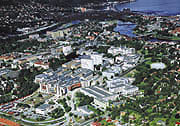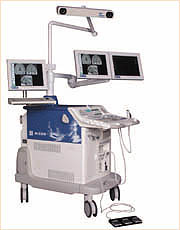|
ERCIM News No.49, April 2002
|
 |
| NTNU main campus. |
 |
|
SonoWand, an ultrasound-based navigation system for image-guided key-hole surgery developed by MISON, a spin-off company from NTNU and SINTEF. MISON is the first company to resolve a compact integration of high quality 3D ultrasound and neuronavigation. They have achieved international recognition for their accomplishments in ultrasound-guided surgery. In December 2001 they were awarded the prestigious European IST Grand Prize for the best IT product in Europe. Neuronavigation systems have become very common in neurosurgery in recent years. Conventional systems offer the capability of navigating surgical instruments into the brain based on MR or CT images that are several days old. As the operation proceeds, such images can no longer be trusted, 'the map does not correspond with the terrain'. SonoWand enables the surgeon to easily update the map during surgery. It takes only a few seconds to scan the brain with high quality 3D ultrasound. The surgeon can then navigate tiny instruments down to the tumor and perform imageguided surgery with high precision (approximately 1mm). Ultrasound images of similar quality as MR-images simplify identification of small remaining tumor structures towards the end of the surgery, and the high precision navigation system simplify localization and removal through a smaller opening in the normal brain. |
The Norwegian University of Science and Technology
is now a Member of ERCIM
NTNU, the Norvegian University of Science and Technology now represents the Norwegian research community in informatics and mathematics including the relevant departments at SINTEF, the University of Oslo, the University of Bergen, the University of Tromsø and the Norwegian Computing Center. Membership was established with support from The Research Council of Norway. Until recently Norway was represented by SINTEF.
The research at NTNU is structured mainly through the basic organisation and five prioritised strategic research areas. The responsibility for ERCIM activities rests with the Faculty of Information Technology, Mathematics and Electrical Engineering (http://www.ime.ntnu.no/eng/). Some of the research activities will be co-ordinated within the framework of the strategic research area of Information and Communication Technology (ICT).
NTNU is the major centre for technological education and research in Norway. Traditions in natural sciences and technology are interwoven with broadly based expertise in the classical university disciplines of the humanities, medicine and the social sciences. The Norwegian Institute of Technology (NTH), founded in 1910 is now an integral part of NTNU.
A specific ambition is to promote cross-disciplinary interplay between all forms of human intellectual activities, the arts, the natural and social sciences and technology. This is considered to be of particular importance when exploiting the opportunities of ICT in promoting the information society and innovations for industrial development.
Membership of ERCIM strengthens our position in contributing to European and international development and in providing Norway with an internationally competitive level of technological know-how.
Professor Arne Sølvberg, Dean at Faculty of Information Technology, Mathematics and Electrical Engineering is heading the ERCIM activities at NTNU. He is a member of the Board of Directors. Professor Finn Arve Aagesen, Head of Department of Telecommuni-cations, is the representative on the Executive Committee.
NTNU key information:
- 7 faculties with a total of
- 79 departments
- 453 professors
- 1,770 other academic staff and doctoral students
- total number of employees: 3300 (37% women)
- at any given time, about 130 academics are on sabbatical
- 20,000 students.
NTNU's research staff is continuously engaged in some 2000 R&D projects. In addition 20-30 major scientific conferences are hosted by NTNU every year. NTNU has bilateral agreements concerning student exchanges with more than 200 foreign universities.
NTNU co-operates closely with SINTEF, a major independent European research institution with about 2,000 employees. SINTEF was established by the university and is located on the university campus. About 25% of the R&D projects of SINTEF are highly relevant to the ERCIM community.
The Faculty of Information Technology, Mathematics and Electrical Engineering has 270 academic staff and doctoral students and is responsible for around 20% of the educational activities at NTNU. The five strategic research areas are:
- Information and Communications Technology (ICT) , with special focus on Web-technology and ICT and learning
- Materials Technology
- Medical Technology and MR
- Energy and Environment
- Marine and Maritime Technology.
Focus Area ICT-Web Technology
NTNU's prioritisation of ICT will ensure access to competent professionals for the ICT industry and for all enterprises and other activities in society that make use of ICT. Our plans are developed in co-operation with business and industry.
The academic diversity at NTNU makes it possible to cover most aspects of ICT in research and teaching. The main areas are:
- computer supported co-operation
- information resources
- user interface
- software and system services
- information transport and networks
- electronics and hardware.
NTNU's research within electrical engineering, computer and information science, mathematics, etc., is not limited to the above-mentioned fields within ICT-web technology. For information about the entire range of subjects, see the outline of subjects under the Faculty of Information Technology, Mathematics and Electrical Engineering (http://www.ime.ntnu.no/eng/). Leader of the focus area ICT-web technology is Professor Arne Sølvberg.
Focus Area ICT and Learning
The strength of this central field lies in the collaboration between pedagogical and technical experts and academic staff who work with the development of knowledge from many different angles. The central field benefits from the collaboration with business and industry and with system suppliers of telecommunications. Important issues in this field of research are:
- the integration of ICT and learning in teaching at NTNU
- the role of ICT in education in primary, secondary and supplementary education
- interdisciplinary communication
- the development and evaluation of ICT-supported methods of teaching
- experimentation with virtual laboratories and distance learning over the Internet.
The Laboratory for ICT and Learning and the NTNU-forum for ICT and learning are central to the research activities. Leader for ICT and Learning is Professor Bjørn Sørenssen, Department of Art and Media Studies, NTNU.
Links:
NTNU main website: http://www.ntnu.no/indexe.php
Faculty of Information Technology, Mathematics and Electrical Engineering: http://www.ime.ntnu.no/eng/
Please contact:
Tore R. Jørgensen, NTNU,
Faculty of Information Technology,
Mathematics and Electrical Engineering
Tel: +47 73598035
E-mail: Tore.R.Jorgensen@ime.ntnu.no